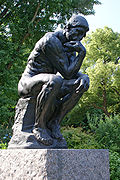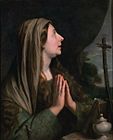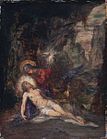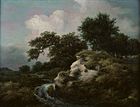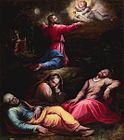- National Museum of Western Art
-
This article is about an art museum in Tokyo, Japan. For other uses, see NMWA (disambiguation).
 National Museum of Western Art, Tokyo designed by Le Corbusier
National Museum of Western Art, Tokyo designed by Le Corbusier
The National Museum of Western Art (国立西洋美術館 Kokuritsu Seiyō Bijutsukan) is the premier public art gallery in Japan specializing in art from the Western tradition.
The Museum is located in the museum and zoo complex in Ueno Park in Taito, central Tokyo. This popular Tokyo museum is also known by the English acronym NMWA (National Museum of Western Art).
Contents
NMWA history
The NMWA was established on June 10, 1959. The museum developed around the core art collection of Matsukata Kojiro (1865-1950), whose thinking is mirrored in the museum he anticipated.
Matsukata's acquisition strategies were designed to create the nucleus of what he hoped would become an evolving national museum specializing in Western art.[1]
The museum exhibits works from the Renaissance to the early 20th century, many having been acquired since the museum's opening. The museum's purpose is to provide the public with opportunities to appreciate Western art.[2]
Since its opening, the museum, as Japan's only national institution devoted to Western art, has been involved in exhibitions, art work and document acquisition, research, restoration and conservation, education and the publication of materials related to Western art.[2]
The museum is involved in the development and organization of a special exhibition every year. These exhibitions feature works on loan from private collections and museums both in and out of Japan.[2] In 1963, NMWA created a splash on the international art scene by bringing together 450 works by the French-Russian artist Marc Chagall. The exhibition brought together Chagall's work from 15 countries, including 8 paintings lent from the Soviet Union; and it was believed to be the most comprehensive show mounted during the artist's lifetime.[3]
NMWA collections
NMWA has purchased art work every year since its establishment in its efforts to build and develop its permanent collection.[2] The museum houses about 4,500 works, including examples of painting and sculpture from the 14th through the beginning of the 20th century. The museum's holdings have expanded in the decades since the museum was first opened to the public:[1]
Paintings; 18th century and earlier
The Main Building displays pre-18th century paintings, including those by Veronese,[4] Rubens,[5] Brueghel, and Fragonard.[6] Many of these paintings are religious paintings featuring imagery from Christianity.Paintings: 19th-20th century
The New Wing displays 19th to early 20th century French paintings, including works by Delacroix, Courbet, Manet, Renoir, Monet, Van Gogh, Gauguin, and Moreau.[7] The galleries also feature works by the next generation of artists, such as Marquet, Picasso, Soutin, Ernst, Miro, Dubuffet and Pollock.[8]Drawings
The NMWA drawing collection centers on works by such 18th to 19th century French artists as Boucher, Fragonard, Delacroix, Moreau, Rodin, and Cézanne.Prints
The prints collection features works by Durer, Holbein, Rembrandt, Callot, Piranesi, Goya, and Klinger, ranging from the 15th century through the early 20th century.[9]Union catalog
The "Union Catalog of the Collections of the National Art Museums, Japan" is a consolidated catalog of material held by the four Japanese national art museums [10]:
- The National Museum of Modern Art, Kyoto (MOMAK).[11]
- The National Museum of Modern Art, Tokyo (MOMAT)
- The National Museum of Art, Osaka (NMAO)
- The National Museum of Western Art (NMWA)
The online version of this union catalog is currently under construction, with only selected works available at this time.[10]
Le Corbusier's building
 National Museum of Western Art, Tokyo. One of the examples of architecture by Le Corbusier
National Museum of Western Art, Tokyo. One of the examples of architecture by Le Corbusier
The Main Building was designed by the Swiss architect Charles-Edouard Jeanneret-Gris (1887-1965), who is more popularly known as Le Corbusier. It is the only representative example of his work in the Far East;[12] and the New York Times review of its opening suggested that the building itself presented an "artistic significance and beauty" which rivaled the paintings inside.[13] The multi-story, reinforced concrete building was completed in March 1959 as a symbol of the resumption of diplomatic ties between Japan and France after World War II.[14]
History of the Commission
The museum was built to house the collection of works gathered by the industrialist Matsukata Kōjirō between 1920 and 1923. His collection had remained in England and France until after World War Two when the Japanese Government asked France for its return to Japan. After France stipulated that a French architect should design the museum that would house the collection, the works were returned to Japan. Le Corbusier was selected for this task.[15]
Le Corbusier designed a masterplan to include the area surrounding the museum. The design itself evolved into a building far exceeding the original brief and the library, a small lecture hall and a room for distinguished guests had to be removed. Nonetheless the removed elements were retained on the plans to provide guidance for future extension.[16]
The Japanese contribution
Le Corbusier asked that his three Japanese apprentices: Kunio Maekawa, Junzo Sakakura and Takamasa Yoshizaka be responsible for developing the detail drawings and supervising the construction.[17]
The building
The museum is square in plan with the main body of the galleries raised on piloti to first floor level. The layout is influenced by Le Corbusier's Sanskar Kendra museum in Ahmedabad which was being designed at the same time.[18]
Entrance for visitors is at ground floor level via the 19th Century Hall. This double height space is lit from above with a north glazed pyramidal skylight intersected with reinforced concrete beams and a column. On the opposite side of the hall from the entrance, the ascent to the paintings gallery is via a promenade ramp which affords better views of Rodin's scupltures. The paintings gallery wraps around 19th Century Hall, the ceiling is initially low but is raised to two storeys around the perimeter to display the paintings. There are also balconies at this level that push back into the 19th Century Hall to re-orient the visitor. Le Corbusier designed the paintings gallery to be lit by natural daylight via four lighting troughs[19], but these are no longer used and the galleries are now artificially lit.[20]
Externally the building is clad in prefabricated concrete panels which sit on U-shaped frames supported by the inner wall. The building generally is constructed of reinforced concrete and the columns have a smooth concrete finish.[21]
After more than two years of construction the building opened on 10 June 1959.[22]
The Modulor
In every element of the building Le Corbusier's Modulor has been applied:
"The modular, which Le Corbusier developed after many years of research, is like a musical scale which gives order to the infinitude of possible musical pitches. Based on the size and proportions of the human body, it is a means of fitting architecture to the human spirit, of ordering the infinitude of possible proportions in such a way as to make them conform to the human shape. In the new Museum of Western Art, the modulor system has been observed in everything from the structural members to the architectural details and furnishings."
- Tadayoshi, Fujiki, August 1959 "The Modular in the National Museum of Western Art" Japan Architect, p48
Additional works to the building
The museum has been added to over the years: Sakakura Associates designed a lecture hall and office building in 1964 and a ticket office in 1984. Whilst Maekawa Associates added a new annex in 1979 and in 1998 in conjunction with the Ministry of Construction, Yokoyama Engineering and Shimizu Construction installed earthquake resistant foundations to the museum.[23]
Recognition
In 1998, the importance of the structure was underscored when it was included in the former Ministry of Construction's survey -- as one of the hundred selected public buildings (the Kokyo Kenchiku 100 Sen) which are outstanding and "well established in the local community."[14]
In 2005 the museum was recognised by the international organisation DOCOMOMO as one of Japan's top one hundred modernist buildings.[24]
In 2007, the building was registered by Japan on a provisional UNESCO list for World Heritage cultural site candidates as an Important Cultural Property at the request of the French government.
Selected artists
- Heinrich Aldegrever (1502-1561), Germany
- Albrecht Altdorfer (1480-1538), Germany
- Edmond Aman-Jean (1860-1936), France
- Jean Arp (1886-1966), France
- Hans Baldung Grien (1484-1554), Germany
- Giovanni Francesco Barbieri (1591-1666), Italy
- Ernst Barlach (1870-1938), Germany
- Leandro Bassano (1557-1622)
- Barthel Beham (1502-1540)
- Hans Sebald Beham (1500-1550), Germany
- Stefano della Bella (1610-1664)
- Émile Bernard (1868-1941), France
- Paul-Albert Besnard (1849-1934), France
- Joachim Beuckelaer (1533-1574), Belgium
- Leonardo Bistolfi (1859-1933), Italy
- William Blake (1757-1827), UK
- Jacques-Emile Blanche (1861-1942)
- Abraham Bloemaert (1564-1651), Netherlands
- Cornelis Bloemaert (1603-1684), Netherlands
- Pierre Bonnard (1867-1947), France
- François Bonvin (1817-1887), France
- Abraham Bosse (1602-1676), France
- François Boucher (1703-1770), France
- Emile-Antoine Bourdelle (1861-1929), France
- Dierick Bouts (1420-1475), Netherlands
- Félix Bracquemond (1833-1914), France
- Georges Braque (1882-1963), France
- Pieter Brueghel (1525-1569), Belgium
- Hendrick ter Brugghen (1588-1629), Netherlands
- Charles Le Brun (1619-1690), France
- Bernard Buffet (1928-1999), France
- Hans Burgkmair (1473-1531), Germany
- Jacques Callot (1592-1635), France
- Giulio Campagnola (1482-1516), Italy
- Robert Campbell[disambiguation needed
 ] (1944-1993), Australia
] (1944-1993), Australia - Canaletto (1697-1768), Italy
- Agostino Carracci (1557-1602), Italy
- Jean-Baptiste Carpeaux (1827-1875), France
- Eugène Carrière (1849-1906), France
- Bernardo Cavallino (1616-1654), Italy
- Paul Cézanne (1839-1906), France
- Marc Chagall (1887-1985), France
- Joos van Cleve (1480-1540), Germany
- Charles-Nicolas Cochin (1688-1754), France
- Edwaert Collier (1640-1707), Netherlands
- Gillis van Coninxloo (1544-1606), Belgium
- Lovis Corinth (1858-1925), Romania
- Jean-Baptiste Corot (1796-1875), France
- Charles Cottet (1863-1925), France
- Gustave Courbet (1819-1877), France
- Charles Antoine Coysevox (1640-1720)
- Lucas Cranach the Elder (1472-1553), Germany
- Carlo Crivelli (1430-1494)
- Salvador Dalí (1904-1989), Spain
- Charles-François Daubigny (1817-1878), France
- Honoré Daumier (1808-1879), France
- Alexandre Gabriel Decamps (1803-1860)
- Edgar Degas (1834-1917), France
- Eugène Delacroix (1798-1863), France
- Maurice Denis (1870-1943), France
- André Derain (1880-1954), France
- Georges Desvallières (1861-1950), France
- Carlo Dolci (1616-1686), Italy
- Kees van Dongen (1877-1968), Netherlands
- Gerrit Dou (1613-1675), Netherlands
- Jean Dubuffet (1901-1985), France
- Raoul Dufy (1877-1953), France
- Jean Duvet (1485-1570)
- Anthony van Dyck (1599-1641), Belgium
- Albrecht Dürer (1471-1528), Germany
- James Ensor (1860-1949), Belgium
- Max Ernst (1891-1976), Germany
- William Etty (1787-1849), UK
- Henri Fantin-Latour (1836-1904), France
- Lyonel Feininger (1871-1956), US
- Georges de Feure (1868-1943), France
- Copley Fielding (1787-1855), UK
- Jean-Louis Forain (1852-1931), France
- Tsuguharu Foujita (1886-1968), Japan
- Jean-Honoré Fragonard (1732-1806), Francis
- Sam Francis (1923-1994), US
- Paul Gauguin (1848-1903), France
- Claude Gellée (1600-1682), France
- Jacques de Gheyn II (1565-1629), Belgium
- Giorgio Ghisi (1512-1582), Italy
- Alberto Giacometti (1901-1966), Czechoslovakia
- Albert Gleizes (1881-1953), France
- Vincent van Gogh (1853-1890), Netherlands
- Hendrick Goltzius (1558-1616), Germany
- Francisco de Goya (1746-1828), Spain
- Jan van Goyen (1596-1656), Netherlands
- El Greco (1541-1614), Greece
- Richard Hamilton (1922- ), UK
- Cornelis de Heem (1631-1695)
- Jean-Jacques Henner (1829-1905), France
- Auguste Herbin (1882-1960), France
- William Hogarth (1697-1764), UK
- Hans Holbein (1497-1543), Germany
- Jean-Auguste Ingres (1780-1876), France
- Tim Johnson[disambiguation needed
 ] (1947- ), Australia
] (1947- ), Australia - Jacob Jordaens (1593-1678), Belgium
- Wassily Kandinsky (1866-1944), Russia
- Max Klinger (1857-1920), Germany
- Käthe Kollwitz (1867-1945), Germany
- Alfred Kubin (1877-1959), Germany
- Nicholas Lancret (1690-1743)
- Nicolas de Largillière (1665-1746), France
- Jean Launois (1898-1942)
- Ernest Laurent (1859-1929)
- Le Corbusier (1887-1965), Czechoslovakia
- Bernard Leach (1887-1979), Hong Kong
- Henri Lebasque (1865-1937), France
- Fernand Léger (1881-1955), France
- Alphonse Legros (1837-1911), France
- Stanislas Lépine (1835-1892)
- Lucas van Leyden (1489-1533)
- Léon Augustin Lhermitte (1844-1925), France
- Pietro Longhi (1702-1785), Italy
- Alessandro Magnasco (1667-1749), Italy
- Aristide Maillol (1861-1944), France
- Édouard Manet (1832-1883), France
- Andrea Mantegna (1431-1506), Italy
- Henri Matisse (1869-1954), France
- Charles Meryon (1821-1868), France
- John Everett Millais (1829-1896), UK
- Jean François Millet (1814-1875), France
- Joan Miró (1893-1983), Spain
- Paula Modersohn-Becker (1876-1907), Germany
- Amedeo Modigliani (1884-1920), Italy
- Claude Monet (1840-1926), France
- Bartolomeo Montagna (1440-1523), Italy
- Adolphe Joseph Thomas Monticelli (1824-1886)
- Henry Moore (1898-1986), UK
- Gustave Moreau (1826-1898), France
- Sally Morgan (1951- )
- Alphonse Mucha (1860-1939), Czechoslovakia
- Edvard Munch (1863-1944), Norway
- Bartolomé Esteban Murillo (1618-1682), Spain
- Jean-Marc Nattier (1685-1766)
- Robert Owen (1937- ), Australia
- Arturo Pacheco Altamirano (1903-1978)
- Samuel Palmer (1805-1881), UK
- George Papazov (1894-1972)
- Mike Parr (1945- ), Australia
- Jules Pascin (1885-1930)
- Jean-Baptiste Pater (1695-1736)
- Joachim Patinir (1475-1524), Belgium
- Pablo Picasso (1881-1973), Spain
- Francesco Piranesi (1778-1810)
- Giovanni Battista Piranesi (1720-1778), Italy
- Camille Pissarro (1830-1903), US
- Jackson Pollock (1912-1956), US
- Paulus Pontius (1603-1858), Belgium
- Pierre Puvis de Chavannes (1824-1898), France
- Odilon Redon (1840-1916), France
- Guido Reni (1575-1642), Italy
- Pierre-Auguste Renoir (1841-1919), France
- Alfred Rethel (1816-1959)
- Joshua Reynolds (1723-1792), UK
- José de Ribera (1591-1652), Spain
- Rembrandt van Rijn (1606-1669), Netherlands
- Henri Rivière (1864-1951), France
- Hubert Robert (1733-1808), France
- Auguste Rodin (1840-1917), France
- Félicien Rops (1833-1898), Belgium
- Salvatore Rosa (1615-1673), Italy
- Dante Gabriel Rossetti (1828-1882), UK
- Georges Rouault (1871-1958), France
- Peter Paul Rubens (1577-1640), Germany
- Ed Ruscha (1937- ), US
- Jacob van Ruysdael (1630-1681), Netherlands
- Egidius Sadeler (1570-1629), Belgium
- Francesco Salviati (1510-1563)
- Ary Scheffer (1795-1858), Netherlands
- Martin Schongauer (1450-1491), France
- Cornelis Schut (1597-1655)
- Giovanni Segantini (1858-1899), Italy
- Daniel Seghers (1590-1661)
- Jacopo del Sellaio (1442-1493)
- Paul Sérusier (1864-1927), France
- Ben Shahn (1898-1969)
- Paul Signac (1863-1935), France
- Alfred Sisley (1839-1899), France
- John Sloan (1871-1951), US
- Chaïm Soutine (1893-1943), Romania
- Jan Steen (1626-1679), Netherlands
- Herman van Swanevelt (1600-1655)
- David Teniers the Younger (1610-1690), Belgium
- David Teniers the Elder (1582-1649)
- Giovanni Battista Tiepolo (1696-1770), Italy
- Giovanni Domenico Tiepolo (1727-1804), Italy
- Jacopo Tintoretto (1518-1594), Italy
- Jan Toorop (1858-1928)
- Henri de Toulouse-Lautrec (1864-1901), France
- Georges de la Tour (1593-1653), France
- Joseph Mallord William Turner (1775-1851), UK
- Adriaen van Utrecht (1599-1653)
- Armand Vaillancourt (1929), Canada
- Félix Vallotton (1865-1925), Czechosolvakia
- Giorgio Vasari (1511-1574), Italy
- Agostino Veneziano (1490-1536)
- Claude Joseph Vernet (1714-1789), France
- Paolo Veronese (1528-1588), Italy
- Jacques Villon (1875-1963), France
- Maurice de Vlaminck (1876-1958), France
- Heinrich Vogeler (1872-1942), Germany
- Lucas Vorsterman (1595-1675)
- Marten de Vos (1532-1603)
- Édouard Vuillard (1868-1940), France
- Rogier van der Weyden (1399-1464), Belgium
- James McNeill Whistler (1834-1903), US
- Richard Wilson (1714-1782), UK
Collection gallery
Notes
- ^ a b NMWA collection
- ^ a b c d NMWA outline
- ^ Chapin, Emerson. "Japan Assembling a Large Chagall Show; 450 Works From 15 Nations to Be Lent For Tokyo Display; Value of Exhibition Estimated at Nearly $14 Million Planned for 7 Years Designed by Le Corbusler," New York Times. September 24, 1963.
- ^ NMWA 14th-16th centuries
- ^ NMWA 17th century
- ^ NMWA 18th century
- ^ NMWA pre-WWII artists
- ^ NMWA post-WWII artists
- ^ NMWA prints study
- ^ a b IAI-National Museums of Art union catalog
- ^ MOMAK union catalog
- ^ Watanabe, Hiroshi. (2001). The Architecture of Tokyo: An Architectural History, pp. 123-124.
- ^ Falk, Ray. "French Art in Tokyo," New York Times. June 21, 1959.
- ^ a b NMWA building
- ^ Reynolds , (2001), p177
- ^ Sakakura, (1959), p36
- ^ Reynolds , (2001), p177
- ^ Reynolds , (2001), p178
- ^ Sakakura, (1959), p44
- ^ "Discover Architecture Map", The National Museum of Western Art
- ^ Sakakura, (1959), p44
- ^ Sakakura, (1959), p36
- ^ Reynolds , (2001), p179
- ^ Spring 2005, "Do_co,mo.mo Japan: the 100 selection", The Japan Architect, No57
References
- Watanabe, Hiroshi. (2001). The Architecture of Tokyo: An Architectural History. Tokyo: Edition Axel Menges. 10-ISBN 3-930698-93-5
- Bijutskan, Kokuritsu Seiyo. (1978). Masterpieces of the National Museum of Western Art, Tokyo. Tokyo: National Museum of Western Art.
- Sakakura Junzo, August 1959, "On the Opening of the National Museum of Western Art", Japan Architect
- Reynolds, Jonathan M. (2001). Maekawa Kunio and the Emergence of Japanese Modernist Architecture. University of California Press. ISBN 0-520-21495-1.
See also
External links
- National Museum of Western Art website
- See panoramic 360° view of NMWA plaza, including Rodin sculpture
Coordinates: 35°42′56″N 139°46′33″E / 35.71556°N 139.77583°E
Categories:- Art museums and galleries in Tokyo
- Le Corbusier buildings
- Ueno Park
Wikimedia Foundation. 2010.

